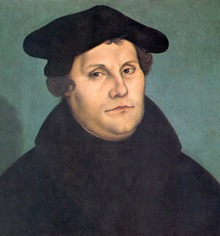Well, today, but 498 years ago, Martin Luther pinned the 95 Theses on the doors of the Wittenberg Church as a protest of what the Dominicans were doing.
One of the things which the Dominicans did to collect money to rebuild St. Peter's Basilica, in Rome, was selling indulgences to the sinners in order to eliminate their sins; the unique incentive of Luther to write the '95 Theses' was to observe how the Dominicans abused of the people.
In the '95 Theses' he rejected the intermediaries between people and God, and expressed his opinion about the equality of the people to God, the unique who could saved or absolve our sins. The Clergy and the court tried to avoid the spreading of the '95 Theses' but they were copied and diffused before it..
In 1521 the Protestant Reformation started when Luther rejected to recant 41 of his thesis
This link will redirect you to Martin Luther's page, where you could found the 95 Theses, and I invite you to watch the film about this,'Luther' it's very interesting and entertaining and you will be able to understand better all this information.
See you!!

https://en.wikipedia.org/wiki/The_Ninety-Five_Theses
A replica of the 95 Theses, in Wittenberg








